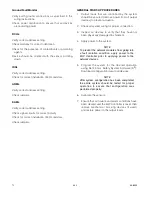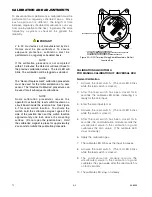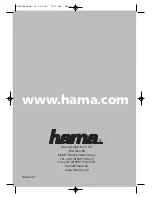
7.1
95-8533
5-6
CALIBRATION ALGORITHM G
FOR DCUs wITH POINTwATCH OR DUCTwATCH
Routine Calibration
1. Apply the zero gas.
2. Activate the reed switch for at least 4 seconds.
(The red LED flashes for 3 seconds while the
switch is activated.)
3. The calibrate LED flashes, indicating it is ready for
the zero input.
4. When a steady zero reading is obtained, the
communication module records the uncalibrated
value in the calibration log and calibrates the zero
value during this time. The LED stays on steady.
5. Apply calibration gas. (The calibrate LED flashes
when the sensor detects gas.)
6. When the sensor input has been stable for 30
seconds, the communication module records the
uncalibrated value in the calibration log and
calibrates the span value.
7. The calibrate LED stays on steady.
8. Remove the calibration gas.
9. The communication module waits until the sensor
input drops below 4% full scale.
10. The calibration is complete. (The calibrate LED
turns off.)
NOTE
Calibration is aborted if not complete within 12
minutes. If not completed, the detector will revert
back to the previous calibration values. The red
LED will flash and the calibration will be logged
as aborted.
Sensor Replacement
wARNING!
The hazardous area must be de-classified prior
to removing a junction box cover with power
applied.
1. Remove power from the DCU and PointWatch/
DuctWatch unit. Replace the PointWatch unit.
Apply power. Press the Sensor Replacement
Switch on the communication module for
approxImately 1 second.
NOTE
Allow at least 10 minutes for the sensor to warm
up.
NOTE
Pressing the Sensor Replacement Switch
prevents the communication module from
generating a fault signal when the input drops to
zero.
NOTE
The calibration will not be aborted if the
calibration procedure is not completed within 12
minutes.
2. Apply zero gas.
3. The calibrate LED flashes, indicating that it is
ready for the zero input.
4. Continue from step 4 of the PointWatch/DuctWatch
routine calibration procedure described above.
DEVICE CALIBRATION LOGS AND
RECORDS
The DCU keeps a calibration log in non-volatile
memory that can be used by the operator to evaluate
the remaining life of some sensors. This log includes
the zero, span, date and time for each successful
calibration. An aborted calibration is indicated by
zeros in the zero and span values. The calibration log
is cleared when the sensor replacement switch is
pressed and the calibration is successfully
completed.
The initial calibration is logged in position one, where
it remains for the life of the sensor. If more than 8
calibrations are performed without the sensor
replacement switch being pressed, the newest
calibration data will replace the second oldest so that
the initial calibration data can be saved. The old
calibration data will be lost. This feature enables
sensor sensitivity trending to aid in maintenance or
troubleshooting.
The analog value for the sensor is represented in raw
analog-to-digital counts 0 to 4095, where 0 represents
0 ma and 4095 represents 24 ma.
TROUBLESHOOTING
Tables 5-1 and 5-2 are provided to assist in locating
the source of a system problem.
Содержание DET-TRONICS 95-8533
Страница 1: ...Instructions 95 8533 Eagle Quantum Premier Fire and Gas Detection Releasing System 7 1 9 09 95 8533 ...
Страница 128: ...7 1 95 8533 A 4 Figure A 1 System Drawing 007545 001 ...
Страница 129: ...95 8533 A 5 7 1 Figure A 2 System Drawing 007545 001 ...
Страница 131: ...95 8533 7 1 B 2 Figure B 1 Drawing 007546 001 ...
Страница 132: ...95 8533 7 1 B 3 Figure B 2 Drawing 007546 001 ...
Страница 134: ...95 8533 7 1 C 2 Figure C 1 Drawing 007547 001 ...
Страница 141: ...95 8533 7 1 D 7 Figure D1 System Drawing 007545 001 ...
Страница 143: ...APPENDIX E E 1 95 8533 7 1 ...
















































